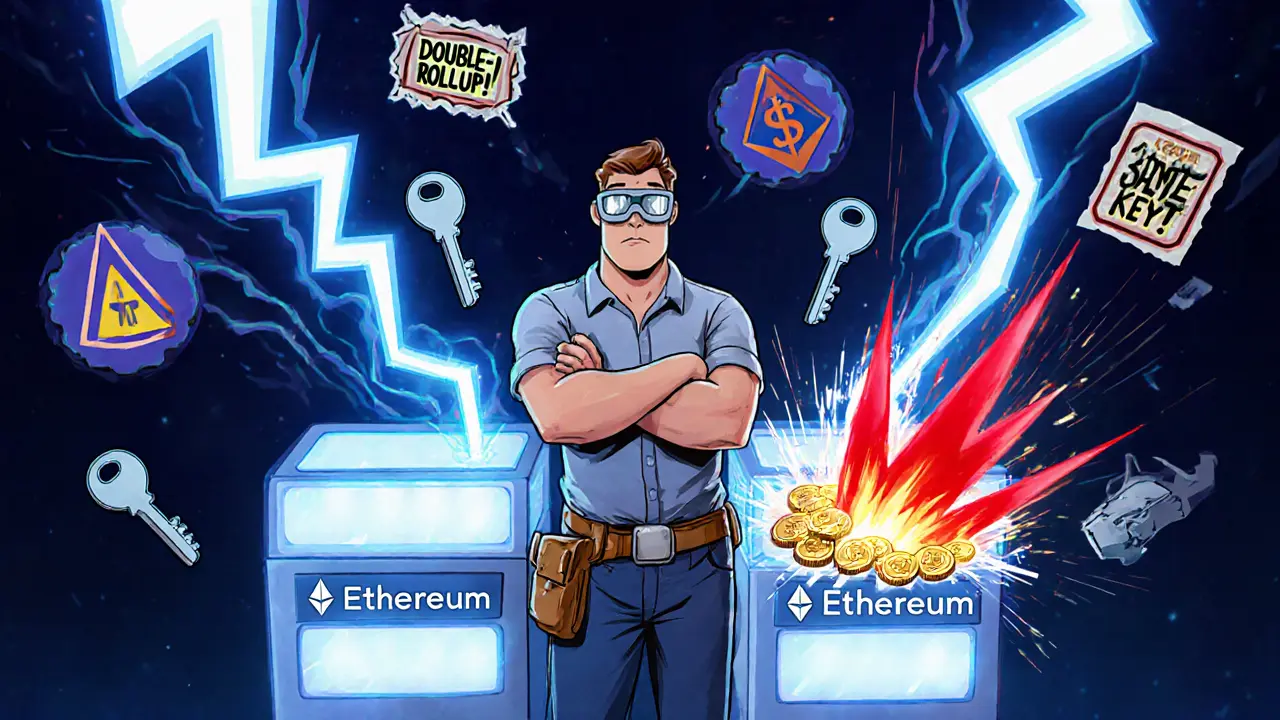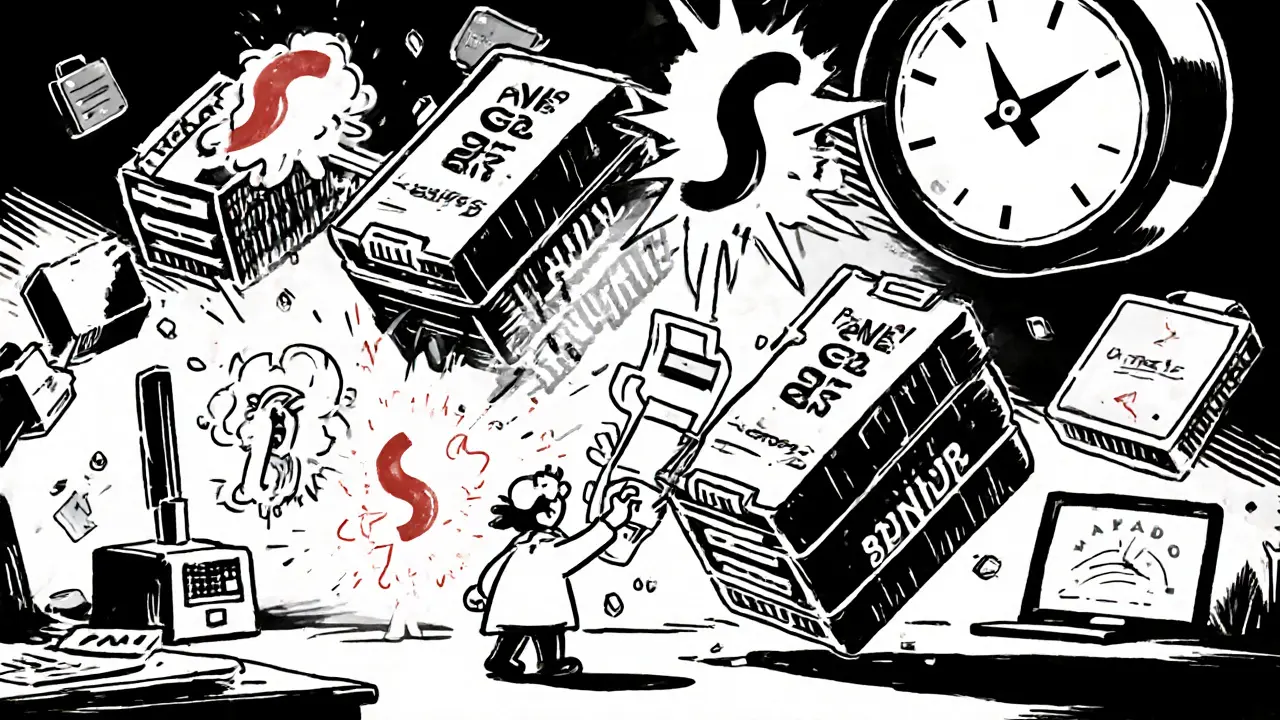How to Slash Restaking Risks: A Practical Guide for Validators and Stakers

Oct, 30 2025
Slashing Risk Calculator
Input Your Restaking Configuration
Risk Assessment
Potential Loss
$0.00 ETH
Risk Level
Recommendations
Restaking sounds simple: you stake your ETH, then reuse that same stake to secure other blockchains or protocols. More yield, less capital. But beneath the surface, there’s a hidden danger-slashing. And in restaking, it doesn’t just cost you rewards. It can wipe out your entire stake.
What Is Slashing, Really?
Slashing isn’t a fine. It’s not a warning. It’s not even a temporary lock. Slashing is the blockchain burning your staked ETH-permanently-as punishment for breaking the rules. It’s the system’s way of saying, "You broke consensus, so you lose everything." On Ethereum, slashing happens for three main reasons:- You sign two different blocks for the same slot (double-signing)
- You attest to blocks that "surround" another block (trying to rewrite history)
- You vote on two different validators for the same checkpoint (double-voting)
Why Restaking Makes Slashing Worse
Restaking means your ETH isn’t just securing Ethereum anymore. It’s also securing a rollup, a liquid staking protocol, or a decentralized oracle network. Each of those has its own rules, its own slashing conditions, and its own failure modes. Imagine running a validator node for Ethereum. You’ve got your keys locked down, your monitoring alerts set up, your uptime at 99.9%. You’re golden. Now, you restake that same stake on a second chain. Suddenly, you need to run two separate validator clients. Two sets of software. Two networks to monitor. Two ways to mess up. The biggest risk? Double-signing across networks. If you use the same signing key for both your Ethereum validator and your restaked rollup validator-and both nodes get triggered at the same time-you’re signing two different messages with the same key. To the blockchain, that looks like an attack. Result? Slashed. Even downtime becomes more dangerous. On some restaking protocols, if your node goes offline for more than 12 hours, you’re penalized. Not just missed rewards-actual stake reduction. And if you’re restaking across five different services? One node down, and you’re losing money on all five at once.Who Gets Slashed? Real-World Scenarios
You might think slashing only happens to amateurs. It doesn’t. In 2023, a well-known staking provider lost 17 ETH from a single slashing event. Why? They used a cloud provider’s auto-restart feature on their validator server. The server crashed. The cloud platform rebooted it. But the old process didn’t fully die. Two validator clients were running at the same time. Same key. Same slot. Slashed. Another case: a small operator set up a backup node in a different data center for redundancy. Perfect. Except they copied the same key folder to both machines. No one realized until the second node signed a block 30 seconds after the first. Two signatures. One key. Slashed. Even big players aren’t immune. Consensys Staking claims zero slashing since Ethereum’s launch-but they’ve spent millions on infrastructure. They use remote signing, key sharding, and air-gapped hardware. Most people don’t have that budget.
How to Avoid Slashing (Step by Step)
You don’t need to be a crypto billionaire to stay safe. Here’s what actually works:- Never reuse keys across networks. Each validator-Ethereum, restaked service, sidechain-needs its own unique signing key. Copying folders is a death sentence.
- Use remote signing. This means your private key lives on a separate, offline device. Your validator node talks to it over a secure channel. Even if your main server gets hacked, the key stays safe. Tools like Keystone or SSV Network make this easier.
- Split your infrastructure. Run your Ethereum validator on one cloud provider. Run your restaked services on another. Don’t put all your nodes on AWS. Don’t use the same VPS. Isolation reduces the chance of one failure taking everything down.
- Monitor everything. Use tools like validators.monitor, Beaconcha.in, or custom Prometheus alerts. Watch for: missed attestations, double-signing attempts, low disk space, high CPU, and unexpected restarts. Set up SMS or Discord alerts for anything out of the ordinary.
- Update early, update often. Ethereum upgrades happen every 4-6 weeks. Restaking protocols update even faster. If you miss a client update, you risk being slashed for outdated protocol rules. Subscribe to official GitHub repos. Don’t rely on forum posts.
- Test your failover. Once a quarter, simulate a node crash. Does your backup activate cleanly? Do the keys stay separate? Do you get alerts? If you’ve never tested it, you’re gambling.
The Hidden Cost: Reputation
Slashing isn’t just about lost ETH. It’s about lost trust. If you’re a validator running for delegators, one slashing event can kill your business. Delegators don’t care if you were hacked. They don’t care if it was a bug. They just see your name on a slashing tracker. And they run. In 2024, a top-tier staking provider lost 60% of its delegated ETH after a single slashing incident. It took them nine months to rebuild trust. They had to publish forensic reports, open their infrastructure to audits, and offer fee discounts. Even then, some delegators never came back. Reputation in staking is like credit scores in traditional finance. One missed payment? You’re flagged. One slashing? You’re blacklisted.Restaking Platforms: Are They Safe?
Many people avoid running their own nodes. They use platforms like Lido, Rocket Pool, or EigenLayer. Are these safer? Sometimes. But not always. Platforms handle the technical stuff. That’s good. But they also centralize risk. If EigenLayer’s infrastructure has a flaw, thousands of restakers get slashed at once. And you don’t get to choose your validator. You’re trusting someone else’s setup. If you’re using a platform, ask:- Do they use remote signing?
- Do they publish slashing incident reports?
- Do they have insurance or compensation funds for slashed stakers?
- Are they transparent about their node locations and redundancy?

What About Institutional Stakers?
Asset managers, family offices, and crypto funds are moving into restaking. But they’re not treating it like crypto. They’re treating it like bonds. They demand:- Third-party audits of validator infrastructure
- Insurance policies covering slashing losses
- Multi-signature key management
- Geographic redundancy (nodes in Europe, Asia, North America)
- Clear SLAs (service level agreements) on uptime and slashing guarantees
The Future of Slashing
As restaking grows, slashing penalties could get harsher. Why? Because the value secured by restaking is rising. EigenLayer alone secures over $10 billion in restaked ETH. If a single attack could drain that, the network has to respond with extreme force. But there’s a flip side. Too harsh penalties scare away validators. Fewer validators = less decentralization = more risk. The balance is fragile. Right now, Ethereum slashes 0.5% of your stake for a first offense. That’s already severe. Some experts predict it could rise to 1% or even 2% in the next 18 months. The takeaway? Don’t wait for slashing to happen. Prepare for it now.Final Checklist: Are You Safe?
Before you restake, run through this:- ✅ Do I have unique keys for each service?
- ✅ Am I using remote signing?
- ✅ Are my nodes spread across different providers?
- ✅ Do I have real-time monitoring and alerts?
- ✅ Have I tested my backup system?
- ✅ Do I know the slashing rules for every protocol I’m restaking on?
- ✅ Have I reviewed the platform’s slashing history and insurance policy?
Restaking offers real yield. But it’s not passive income. It’s active security. And if you treat it like a set-and-forget feature, you’re already one misconfiguration away from losing everything.
Can I get slashed just for being offline?
Not always. On Ethereum, being offline only means you miss rewards-you don’t get slashed. But some restaking protocols, especially newer ones, have stricter liveness rules. If your node is down for more than 12 hours on a restaked chain, you could lose part of your stake. Always check the specific protocol’s rules before restaking.
Is restaking safer than regular staking?
No. Restaking is riskier. You’re exposing your stake to more failure points. Regular staking only requires you to secure one chain. Restaking means securing multiple chains, each with different rules, updates, and slashing conditions. More complexity = more ways to fail.
What’s the difference between slashing and penalization?
Slashing means your ETH is permanently destroyed. Penalization means you lose future rewards for being offline or slow. Slashing is a punishment for malicious or dangerous behavior. Penalization is a gentle nudge for poor performance. Slashing is rare. Penalization is common.
Can I insure against slashing?
Some platforms offer insurance. Lido, for example, has a slashing protection fund backed by its treasury. But most individual validators can’t buy insurance. If you’re a large staker, you can work with crypto-focused insurers like Nexus Mutual or InsurAce-but coverage is limited and expensive. Don’t assume you’re protected unless you’ve explicitly signed up for it.
Do I need a hardware wallet for restaking?
Not necessarily, but you need secure key storage. A hardware wallet (like Ledger or Keystone) is ideal for signing keys because it keeps them offline. If you’re using software keys on a server, you’re at risk of hacking. For restaking, treat your signing keys like gold-lock them up, don’t leave them online.
What happens if I get slashed on one chain but not others?
You lose the stake tied to that chain. If you restaked 10 ETH across five protocols, and one of them slashes you for 3 ETH, you lose only those 3 ETH. But your reputation is damaged across all networks. Many platforms will automatically remove you from their validator pools after any slashing event-even if it happened on a different chain.
Can I recover from a slashing event?
You can’t recover the lost ETH. But you can recover your reputation. That takes time: public transparency, detailed incident reports, improved security, and consistent uptime for months. Some validators rebuild trust in 6-12 months. Others never do. The market doesn’t forgive easily.